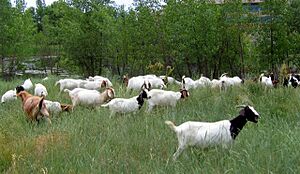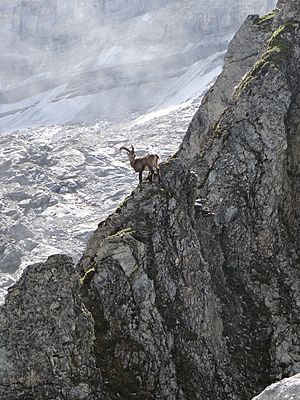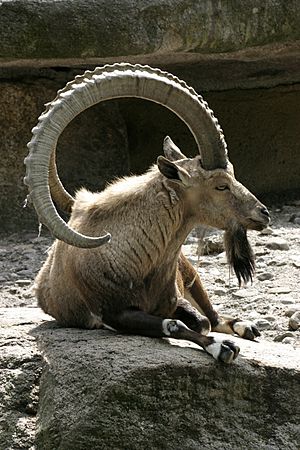Capra (genus) facts for kids
Quick facts for kids Capra |
|
|---|---|
 |
|
| Female ibex | |
| Scientific classification | |
| Kingdom: | |
| Phylum: | |
| Class: | |
| Order: | |
| Family: | |
| Subfamily: | |
| Genus: |
Capra
Linnaeus, 1758
|
Capra is the scientific name for a group of amazing mammals we know as goats or wild goats. This group includes up to nine different species. Some well-known members are the wild goat, the markhor, and several types of ibex. The familiar domestic goat is actually a special kind of wild goat that humans have tamed. People started taming goats over 8,500 years ago!
Wild goats are expert climbers. They live in tough mountain areas. These animals are super agile and strong. They can climb steep, rocky slopes and find food even where plants are scarce. You can tell a wild goat apart from a sheep (which belongs to the Ovis group) by a few things. Goats have special scent glands near their feet, groin, and eyes. Male goats often have beards. Also, goats have tough, hairless patches on their front knees.
It's important to know that the Rocky Mountain goat is not a true goat. It belongs to a different group called Oreamnos.
Goats and People: A Long History
Goats were some of the very first animals that humans tamed. This process of domestication began at least 10,000 years ago. It happened in an area that is now northern Iran. People wanted goats mainly for their hair, meat, and milk.
In ancient times and up until the Middle Ages, goat skins were very useful. People used them to carry water and wine when they traveled or went camping. Goat skins were also used to make parchment, which was a material for writing.
Types of Wild Goats
The Capra group includes many interesting species. Here are some of them:
- Wild Goat (Capra aegagrus): This is the ancestor of the domestic goat.
- Alpine Ibex (Capra ibex): A strong mountain goat found in the European Alps.
- Walia Ibex (Capra walie): This rare ibex lives only in the mountains of Ethiopia.
- West Caucasian Tur (Capra caucasica): A large goat found in the western Caucasus Mountains.
- East Caucasian Tur (Capra cylindricornis): Another type of tur, living in the eastern Caucasus.
- Spanish Ibex (Capra pyrenaica): Found in the mountains of the Iberian Peninsula.
- Markhor (Capra falconeri): This goat has amazing spiral horns and is the national animal of Pakistan.
Images for kids
See also
 In Spanish: Cabras para niños
In Spanish: Cabras para niños






